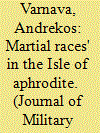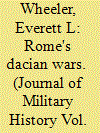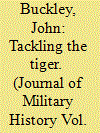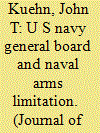| Srl | Item |
| 1 |
ID:
100737


|
|
|
|
|
| Publication |
2010.
|
| Summary/Abstract |
Countless writers have speculated on Robert E. Lee's motivations for the Gettysburg campaign during the American Civil War. One significant factor has received less attention than others: the need to clear the Shenandoah Valley of occupying Union forces. This essay argues that the situation in the Shenandoah Valley was a key part of Lee's conceptualization of the campaign and his analysis of its results. This perspective illuminates the issues of logistics and home front discontent that confronted Lee and made him begin planning his operation well before April 1863. It supports and broadens recent work highlighting the importance of logistics in the campaign.
|
|
|
|
|
|
|
|
|
|
|
|
|
|
|
|
| 2 |
ID:
100742


|
|
|
|
|
| Publication |
2010.
|
| Summary/Abstract |
In 1945, the British and American chiefs of staff ordered that information about the Allied solution of German cryptosystems be excluded from their official histories of World War II in order to preserve an intelligence advantage. This left the world with an incomplete but not an erroneous account of that struggle. Despite a few leaks, not until Group Captain F. W. Winterbotham revealed those solutions in 1974 did that story begin to emerge fully. An unexpected consequence was to bolster British pride.
|
|
|
|
|
|
|
|
|
|
|
|
|
|
|
|
| 3 |
ID:
100736


|
|
|
|
|
| Publication |
2010.
|
| Summary/Abstract |
In the nineteenth century European powers employed "natives" perceived to be inherently "martial" as the mainstay of their imperial armed forces. This theory of "martial races" undergirded the composition, for example, of Britain's Indian Army. An attempt in the 1890s to apply "martial races" theory to the formation of an indigenous defence force in Cyprus, however, proved to be an unqualified failure. Although the British government claimed that the scheme fell through because of inadequate funds, the main reason was that the decision to recruit the force exclusively from among the presumably more "martial" Turkish Muslim population of the island contradicted local ideas of identity by dividing Cypriots into "Greeks" and "Turks," with unhappy consequences for the future.
|
|
|
|
|
|
|
|
|
|
|
|
|
|
|
|
| 4 |
ID:
100741


|
|
|
|
|
| Summary/Abstract |
wo recent major monographs, one on the Dacian wars of Domitian and Trajan (Stefan) and another on ancient migrations from the Ukraine into the eastern Balkans (Batty, Rome and the Nomads) invite discussion and evaluation. A survey of the problematic literary and archaeological sources (not least Trajan's Column) for the history of this area in the first and second centuries A.D. prefaces an evaluation of new archaeological evidence on Dacian defenses and innovative topographical identifications. The development of a Geto-Dacian state in Transylvania within the context of multiple ethnicities on the Lower and Middle Danube is discussed and use of new archaeological discoveries to clarify narratives of the wars of 84-89, 101-102, and 105-106 is evaluated. Interpretations of scenes on Trajan's Column and the metopes of the Adamklissi monument remain controversial.
|
|
|
|
|
|
|
|
|
|
|
|
|
|
|
|
| 5 |
ID:
100740


|
|
|
|
|
| Publication |
2010.
|
| Summary/Abstract |
The British Army of the Second World War does not retain a positive reputation in the field of operational and tactical battle doctrine, particularly so in armoured warfare. Many historians argue that in Normandy in the summer of 1944, British armoured forces had still failed to grasp many essential elements of modern combat. This article demonstrates that in reality the British Army's loose approach to developing and imposing doctrine, despite inherent shortcomings, actually facilitated a flexible attitu
|
|
|
|
|
|
|
|
|
|
|
|
|
|
|
|
| 6 |
ID:
100739


|
|
|
|
|
| Publication |
2010.
|
| Summary/Abstract |
The naval treaty system inaugurated at Washington in 1922 channeled innovation in the U.S. Navy. The Washington Naval Treaty eliminated the ability of the United States to construct new bases or to improve existing ones in the western Pacific. It fell to the General Board of the Navy to implement the clauses of the Washington Treaty. The General Board was also charged with the responsibility of preparing and attending subsequent naval conferences during the period. The General Board was the critical link between the Navy and the naval treaty system. As such, the General Board both shaped and was shaped by the treaty system.
|
|
|
|
|
|
|
|
|
|
|
|
|
|
|
|
| 7 |
ID:
100738


|
|
|
|
|
| Publication |
2010.
|
| Summary/Abstract |
Winston Churchill's propagation of the infamous "ten year rule" has led to charges that he created the deficiencies in Britain's defences that he denounced during the 1930s. This article shows that traditional explanations for Churchill's attacks on defence spending during his tenure as Chancellor of the Exchequer (1924-29) oversimplify his motives and exaggerate his authority. His policies were shaped by a complex and shifting combination of political, financial, strategic, and bureaucratic goals. Churchill was not the instigator of the ten year rule in 1919, and he cannot be held responsible for its effects after leaving office. Even during the 1920s, the impact of the ten year rule was more modest than historians have generally recognized.
|
|
|
|
|
|
|
|
|
|
|
|
|
|
|
|